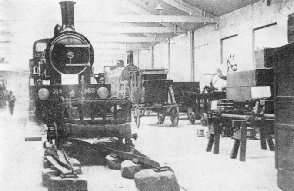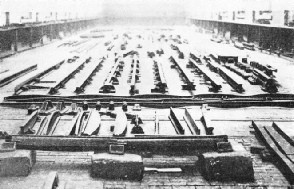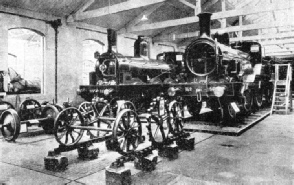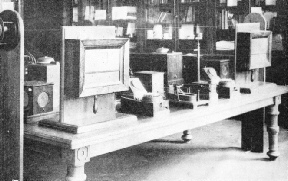
| Donate |
| FAQs |
| More on Railway Wonders |
| Other Series |
| Privacy & Terms of Use |

Through the York Museum
A Fascinating Record of More than a Century of Railway Progress

A GENERAL VIEW of some of the unique exhibits in the railway museum at York. Although the museum was started by the LNER, it is representative of all the British railways.
THE British railways have more than a century of vivid romance behind them; and in the course of their long period of public service they have gathered together many fascinating specimens of early locomotives and various types of equipment, all of which gain added interest as the years steal by.
Until comparatively recently little effort was made to gather together, for exhibition purposes, the many relics of the pioneering days, the valuable examples of locomotives, rolling-
It is to the initiative of the London and North Eastern Railway that we owe this museum. In its establishment the LNER authorities have be en aided considerably by the other three great railways, the idea being that the York exhibits shall not only cover the birth and growth of the LNER system, but also be fully representative of railways throughout Britain. The York Museum does not in any way seek to compete with the Science Museum at South Kensington, London. So whole-
Both sections of the museum are situated within easy reach of the main passenger station. The large exhibits are accommodated in a building that was formerly a locomotive fitting shop, used during the Great War as a munitions works. The main room of the small exhibits section contains prints, photographs, books, timetables, posters, medals, obsolete telegraph instruments, and specimens of early uniforms and equipment. Among the uniforms is a red coat of the kind once worn by passenger guards. This part of the museum also has an example of the goggles which guards used to wear to protect their eyes when they sat perched aloft at the rear of the old-

THE PERMANENT-
A print of George Stephenson occupies the position of honour above the mantelpiece. In this section of the museum is another room devoted to a collection of prints and books, presented to the museum by the late Isaac Briggs, of Wakefield.
To obtain some idea of the ground covered, let us, in imagination, make a tour of the museum.
In the days before railways, travellers who did not own their own carriages had to rely on the “Christmas-
The exhibits of rails are of great historic interest. There are several authentic specimens of the early iron roads built for wheels without flanges. Especially interesting is the portion of the “Outram Way”, with junctions and points complete. This came from the LMSR, Peak Forest Canal, near Chinley. The track was laid by Outram himself in 1797, with cast-
A later type of rail to be adopted was the channel rail. An interesting specimen of this rail is on view dating back to 1809. Behind the channel rail exhibit are several short lengths of cast-
Edge rails for flanged wheels were first introduced in 1789 as an alternative to the tram-
In the York Museum there are to be seen some of the rails used on the original Stockton and Darlington system. As a matter of history, it was only during the construction of this line that George Stephenson decided that wrought iron rails were better than cast iron, a decision that caused him much personal loss, since he was interested financially in the manufacture of the short, bow-

RAIL AND ROAD CO-
A case of rail sections in the museum illustrates the growth in the size of rails from 1830 onwards, the smallest rail in this exhibit being that used on the Leeds and Selby Railway, weighing 36 lb to the yard. Contrasting with this exhibit, there is a photograph of the well-
Undoubtedly the most attractive exhibits in the York Museum are the many historic locomotives, dating from the infancy of railways, and the numerous photographs and diagrams of noteworthy engines. One of the very early locomotives was that made by Matthew Murray for Blenkinsop, of Leeds, in 1811 or 1812. Unfortunately, the original engine has disappeared, but in the museum there is an interesting contemporary print of the machine. The Blenkinsop locomotive was of the rack-
Another interesting print in the museum shows the Hedley engine of 1813, the first smooth-
George Stephenson’s first locomotive was made in 1814. It was an adhesion locomotive, with two cylinders, and is said to have drawn eight loaded carriages, or 30 tons, on a slightly rising gradient, at four miles an hour. This was, of course, a big advance on any previous locomotive. So successful did it prove that George Stephenson was called upon to provide locomotives for various collieries, and early in the eighteen-
Long Service
The pride of the York Railway Museum is the original “Hetton” locomotive of George Stephenson and Nicholas Wood, built at the Hetton Colliery workshops in 1822. It was rebuilt in 1857, and again in 1882, when the present link motion was fitted.
It is not quite clear for how long the engine worked, but, according to some authorities, it was in harness until 1913. Under its own steam, the “Hetton” led the Railway Centenary procession of old and modern locomotives at Darlington, on July 2, 1925.
Before we come to the other locomotive exhibits in the York Museum, our attention is directed to an interesting display consisting of the lathe wheel and the tools used by George Stephenson in making his early engines.
Among these tools is a number of “taps” used in threading holes for screws, these being the same in principle as the tools employed to-
Another exhibit is George Stephenson’s report on the Stockton and Darlington Railway, dated January, 1822. This is the original report, written in a school exercise book. The first survey was made in 1818 by a Welsh engineer named Overton. The original Parliamentary Bill for the Stockton and Darlington Railway was defeated, and it was only after the Bill for the railway was passed, in 1821, that George Stephenson was asked to undertake a new survey. It appears that the line was intended to be worked by horses, and Stephenson was engaged, not as a mechanical engineer, but as a civil engineer.
Now we come to prints of two other early locomotives -
Two ancient locomotives that now claim our attention are the “Derwent” and “Engine 1035”. The “Derwent”, which was preserved on the main platform at Darlington Station, is represented at York by a photograph. It was built in 1845 by Alfred Kitching, and is a six-
Next to the “Hetton” engine in popularity comes the first of Patrick Stirling’s famous “8-
The “Stirling No. 1” took a prominent part in the Railway Races of 1888 and 1895, and created a great sensation at the time of its introduction. Another interesting exhibit is “Engine No. 1275” built in 1874. This was known as a “Quaker” engine, because it was designed by William Bouch, a former engineer of the Stockton and Darlington line, which was nicknamed the “Quaker Railway”. It is a mineral engine, built by Dübs and Co., of Glasgow, and has a very long boiler.
Another interesting locomotive on show is “No. 910”, built in 1875 for main-
Continuing our stroll through the museum, we next come to the engine “Gladstone”, in its gay coat of daffodil yellow. This engine was built for the London, Brighton and South Coast Railway in 1882, to the design of William Stroudley, and has many features of special interest, including an arrangement whereby the flanges of the leading wheels are lubricated with a spray of water. When this engine was designed, it was considered rather a novelty to have two wheels of large diameter as leading wheels, and the lubrication was presumably intended to help in the negotiation of curves.
 THE SMALL EXHIBITS SECTION, which contains many historic documents, prints, coats-
THE SMALL EXHIBITS SECTION, which contains many historic documents, prints, coats-
Modern locomotives are represented in York Museum by many interesting photographs and diagrams. There are, for example, the LNER “Pacific” engine, “Enterprise”, weighing with its tender, 159 tons, as compared with the six and a half tons of “Locomotion No. 1”; the “Garratt” type locomotive weighing 176 tons, employed largely for coal train haulage; and the “Mikado” class of machine, fitted with booster, weighing with tender just over 151 tons, and specially adapted for hauling heavy trains of 100 loaded brick wagons between Peterborough and London. These exhibits are an instructive contrast to the old engines of Stephenson’s day.
Leaving the locomotive exhibits behind, we pause to inspect the first iron bridge ever built, two of the three original spans of which are on show at York. The Stockton and Darlington Railway did not end at Darlington, but farther west, its purpose being to convey coals from the West Durham pits to the port of Stockton-

THE PRIDE OF THE YORK MUSEUM, and perhaps the most interesting exhibit of all, is the Hetton Colliery locomotive. Built in 1822 by George Stephenson and Nicholas Wood, the Hetton has an amazing record of long service. It was rebuilt in 1857, and again in 1882. Under its own steam it led the Railway Centenary procession of old and modern locomotives at Darlington on July 2, 1925.
Another interesting exhibit takes the form of a “dandy cart”, to which is attached a life-
Travelling in the early days of railways was something of an ordeal for the third-
Early Telegraph Exhibits
From Bootham Junction, York, there has been brought into the museum the body of a third-
 THREE HISTORIC EXHIBITS. On the left of this picture is the “Quaker” engine, built in 1874 for the Stockton and Darlington section. On the right is the “Tennant” engine, built for the North Eastern Railway Co., in 1885. In the foreground, the Blenkinsop wheels and rack railway, 1812.
THREE HISTORIC EXHIBITS. On the left of this picture is the “Quaker” engine, built in 1874 for the Stockton and Darlington section. On the right is the “Tennant” engine, built for the North Eastern Railway Co., in 1885. In the foreground, the Blenkinsop wheels and rack railway, 1812.
Of the immense number of miscellaneous exhibits in the York Museum, space will permit of reference to only a number of the more important items. Signalling progress is revealed in many attractive displays. Outstanding among these is the only remaining specimen of a signal lamp with coloured slides, as used on the Stockton and Darlington line about 1840. The electric telegraph was first adopted for railway working between Paddington and West Drayton, on the Great Western Railway, in 1838, and in the York Museum there are several exhibits of early telegraph instruments, telegraph forms, and other equipment. Another fine exhibit consists of the block working signalling apparatus used for the operation of the Shildon Tunnel, between the years 1854-
The Briggs’ Collection, to which reference has been made, consists mainly of books, prints and manuscripts relating to the engineering side of railways. It is housed in a separate section of the York Museum, and includes many valuable documents bearing the signatures of George Stephenson, Robert Stephenson, Isambard Brunel, George Hudson, and other railway giants of the past.
One leaves this treasure-
The York Museum presents opportunities for the study of railway matters which are almost unequalled in Britain. The wonderful working models at the Science Museum at South Kensington, London, have, of course, given pleasure and instruction to thousands of visitors, but at York there is accommodation for a large number of prototypes. The full-
 A VIEW OF THE SIGNALLING SECTION AT YORK. This section of the exhibition illustrates the progress made in signals and signalling during the past century. Outstanding among the exhibits is the only remaining specimen of a signal lamp with coloured slides, as used on the Stockton and Darlington line.
A VIEW OF THE SIGNALLING SECTION AT YORK. This section of the exhibition illustrates the progress made in signals and signalling during the past century. Outstanding among the exhibits is the only remaining specimen of a signal lamp with coloured slides, as used on the Stockton and Darlington line.
You can read more on
“Famous Railway Centres -
and
and
and
on this website.